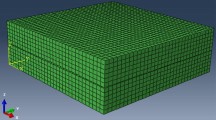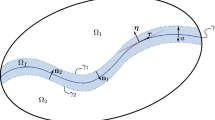Abstract
Laminar, single-phase, finite-volume solutions to the Navier–Stokes equations of fluid flow through a fracture within permeable media have been obtained. The fracture geometry was acquired from computed tomography scans of a fracture in Berea sandstone, capturing the small-scale roughness of these natural fluid conduits. First, the roughness of the two-dimensional fracture profiles was analyzed and shown to be similar to Brownian fractal structures. The permeability and tortuosity of each fracture profile was determined from simulations of fluid flow through these geometries with impermeable fracture walls. A surrounding permeable medium, assumed to obey Darcy’s Law with permeabilities from 0.2 to 2,000 millidarcies, was then included in the analysis. A series of simulations for flows in fractured permeable rocks was performed, and the results were used to develop a relationship between the flow rate and pressure loss for fractures in porous rocks. The resulting friction-factor, which accounts for the fracture geometric properties, is similar to the cubic law; it has the potential to be of use in discrete fracture reservoir-scale simulations of fluid flow through highly fractured geologic formations with appreciable matrix permeability. The observed fluid flow from the surrounding permeable medium to the fracture was significant when the resistance within the fracture and the medium were of the same order. An increase in the volumetric flow rate within the fracture profile increased by more than 5% was observed for flows within high permeability-fractured porous media.
Similar content being viewed by others
References
Al-Yaarubi, A.H., Pain, C.C., Grattoni, C.A., Zimmerman, R.W.: Navier–Stokes simulations of fluid flow through a rock fracture. In: Faybishenko, B., Gale, J. (eds.) Dynamics of fluids and transport in fractured rocks, vol. 162 of AGU Monograph, pp. 55–64. American Geophysical Union, Washington, DC (2005).
Berkowitz B. (2002) Characterizing flow and transport in fractured geological media: a review. Adv. Water Resour. 25: 3151–3175
Brown S.R. (1995) Simple mathematical model of a rough fracture. J. Geophys. Res. 100: 5941–5952
Brown S.R., Caprihan A., Hardy R. (1998) Experimental observation of fluid flow channels in a single fracture. J. Geophys. Res. 103: 5125–5132
Chae B.G., Ichikawa Y., Jeong G.C., Seo Y.S., Kim B.C. (2004) Roughness measurement of rock discontinuities using a confocal laser scanning microscope and the Fourier spectral analysis. Eng. Geol. 72: 181–199
Detournay E. (2004) Propagation regimes of fluid-driven fractures in impermeable rocks. Int. J. Geomech. 4: 34–45
Detwiler R.L., Pringle S.E., Glass R.J. (1999) Measurement of fracture aperture fields using transmitted light: an evaluation of measurement errors and their influence on simulations of flow and transport through a single fracture. Water Resour. Res. 35: 2605–2617
Dougan L.T., Addison P.S., McKenzie W.M.C. (2000) Fractal analysis of fracture: a comparison of dimension exponents. Mech. Res. Commun. 27: 383–392
Drazer G., Koplik J. (2001) Tracer dispersion in two-dimensional rough fractures. Phys. Rev. E 63: 056104
Hirono T., Takahashi M., Nakashima S. (2003) In situ visualization of fluid flow image within deformed rock by X-ray CT. Eng. Geol. 70: 37–46
Ingham D.B., Al-Hadhrami A.K., Elliott L., Wen X. (2006) Fluid flows through some geological discontinuities. J. Appl. Mech. 73: 34–40
Issa M.A., Issa M.A., Islam Md S., Chudnovsky A. (2003) Fractal dimension: a measure of fracture roughness and toughness of concrete. Eng. Fract. Mech. 70: 125–137
Karpyn Z.T., Piri M. (2007) Prediction of fluid occupancy in fractures using network modeling and X-ray microtomography. I: data conditioning and model description. Phys. Rev. E Stat. Nonlin. Soft Matter Phys. 76: 016315
Karpyn Z.T., Grader A.S., Halleck P.M. (2007) Visualization of fluid occupancy in a rough fracture using micro-tomography. J. Colloid Interface Sci. 307: 181–187
Kulatilake P.H.S.W., Um J. (1999) Requirements for accurate quantification of self-affine roughness using the roughness-length method. Int. J. Rock Mech. Min. Sci. 36: 5–18
Lanaro F. (2000) A random field model for surface roughness and aperture of rock fractures. Int. J. Rock Mech. Min. Sci. 37: 1195–1210
Mandelbrot B.B., Passoja D.E., Paullay A.J. (1984) Fractal character of fracture surfaces of metals. Nature 308: 721–722
McKoy, M.L., Sams, W.N.: Tight gas simulation: modeling discrete irregular strata-bound fracture network flow including dynamic recharge from the matrix. Presented at U.S. Department of Energy’s Natural Gas Conference, Number P17, Houston, TX (1997)
Mityushev V., Adler P.M. (2006) Darcy flow around a two-dimensional permeable lens. J. Phys. A. Math. Gen. 39: 3545–3560
Mourzenko V.V., Thovert J.-F., Adler P.M. (2001) Permeability of self-affine fractures. Transp. Porous Media 45: 89–103
National Institutes of Health (U.S.) ImageJ 1.38x. http://rsb.info.nih.gov/ij/. Accessed 13 April 2009
National Research Council (U.S.): (1996) Committee on Fracture Characterization and Fluid Flow: Rock Fractures and Fluid Flow: Contemporary Understanding and Applications. National Academy Press, Washington, DC
Nazridoust K., Ahmadi G., Smith D.H. (2006) New friction factor correlation for laminar, single phase flows through rock fractures. J. Hydrol. 329: 315–328
Odling N.E. (1994) Natural fracture profiles, fractal dimension and joint roughness coefficients. Rock Mech. Rock Eng. 27: 135–153
O’Sullivan M.J., Pruess K., Lippmann M.J. (2001) State of the art geothermal reservoir simulation. Geothermics 30: 395–429
Piri M., Karpyn Z.T. (2007) Prediction of fluid occupancy in fractures using network modeling and X-ray microtomography. II: Results. Phys. Rev. E Stat. Nonlin. Soft Matter Phys. 76: 016316
Poon C.Y., Sayles R.S., Jones T.A. (1992) Surface measurement and fractal characterization of naturally fractured rocks. J. Phys. D. Appl. Phys. 25: 1269–1275
Rangel-German E., Akin S., Castanier L. (2006) Multiphase-flow properties of fractured porous media. J. Petrol. Sci. Eng. 51: 197–213
Roux S., Plouraboué F., Hulin J.-P. (1998) Tracer dispersion in rough open cracks. Trans. Porous Media 32: 97–116
Selroos J.-O., Walker D.D., Ström A., Gylling B., Follin S. (2002) Comparison of alternative modelling approaches for groundwater flow in fractured rock. J. Hydrol. 257: 174–188
Tsang Y.W. (1984) The effect of tortuosity on fluid flow through a single fracture. Water Resour. Res. 20: 1209–1215
U.S. Department of Energy: United States Department of Energy Carbon Sequestration Atlas of the United States and Canada. http://www.netl.doe.gov/technologies/carbon_seq/refshelf/atlas/index.html (2007). Accessed 13 April (2009)
Wang J.S.Y., Narasimhan T.N., Scholz C.H. (1988) Aperture correlation of a fractal fracture. J. Geophys. Res. 93: 2216–2224
White F.M. (1999) Fluid Mechanics, 4th ed. McGraw-Hill, New York
Author information
Authors and Affiliations
Corresponding author
Rights and permissions
About this article
Cite this article
Crandall, D., Ahmadi, G. & Smith, D.H. Computational Modeling of Fluid Flow through a Fracture in Permeable Rock. Transp Porous Med 84, 493–510 (2010). https://doi.org/10.1007/s11242-009-9516-9
Received:
Accepted:
Published:
Issue Date:
DOI: https://doi.org/10.1007/s11242-009-9516-9




